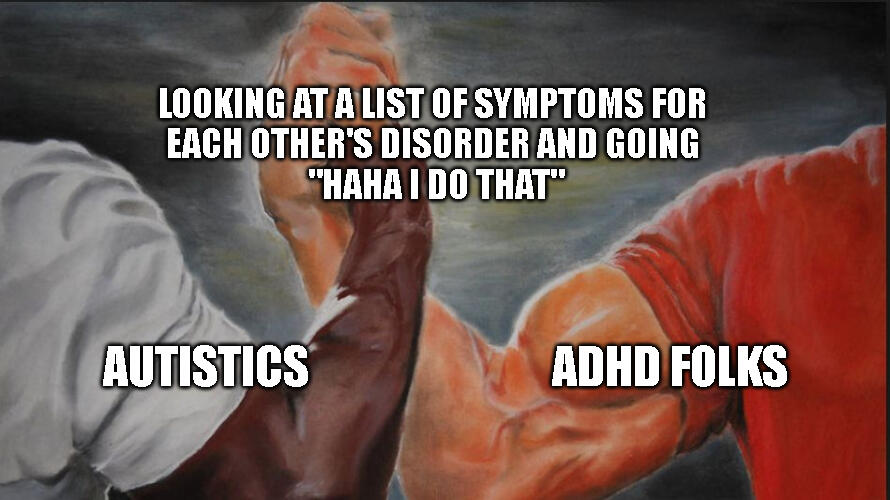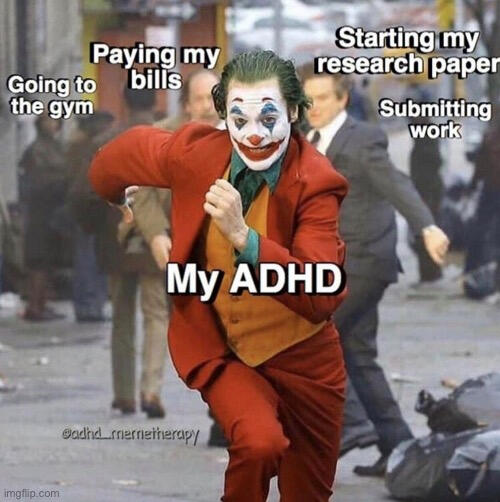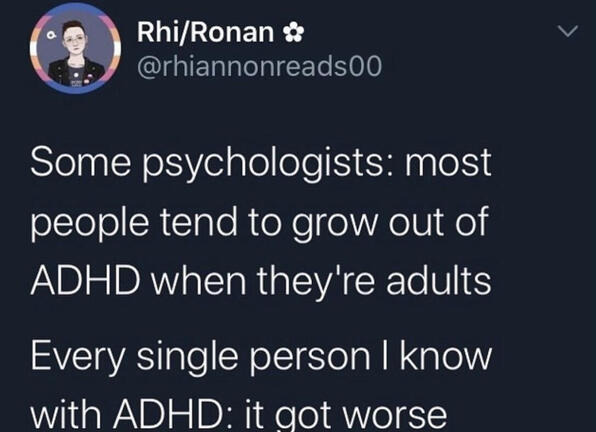ADHD

ADHD, or Attention Deficit Hyperactivity Disorder, is a neurodevelopmental condition characterized by differences in brain development and activity. It affects a person's attention, impulse control, and ability to sit still. It's one of the most common neurodevelopmental disorders and is typically diagnosed in childhood, often continuing into adulthood.
ADHD is also referred to as Self-Regulation Deficit Disorder or Executive Function Development Disorder.
ADHD involves a delay in the development of certain traits, leading to impairment well into adulthood.
Developmental delays can lead to impulsivity, emotional challenges, and association with other conditions like Oppositional Defiant Disorder (ODD) and Slow Cognitive Tempo (SCT)

Individuals with ADHD experience impaired executive function due to a smaller prefrontal cortex, which involves difficulties in persisting toward future goals, resisting distractions, and managing working memory. Unlike most people who, when distracted, can reengage in an incomplete task, those with ADHD struggle due to their impaired working memory.It's more accurately termed Executive Function Development Disorder, emphasizing the challenge of directing behavior forward in time, rather than a processing or filtering issue. For effective support, external physical forms of information such as symbols, charts, reminders, and notes are beneficial. In managing executive function challenges, it's good to use timers due to a lack of an internal clock, close gaps between events and outcomes, and ensure that all motivation comes externally, as individuals with ADHD struggle with self-motivation.Implementing strategies such as a structured deal-based approach, fostering a win-win mindset, using tangible tools for concepts, making mental information physical, and maintaining consistency in rules and consequences can significantly assist in managing ADHD-related executive function difficulties.For children, minimizing nagging and providing frequent rewards along with a structured approach involving 2-3 rules, incentives, punishments, and regular reviews can be highly effective.

Individuals with ADHD face an 11-fold increased likelihood of developing Oppositional Defiant Disorder (ODD), as the criteria for ADHD and ODD align closely.Additionally, what was previously considered ADD (Attention Deficit Disorder) but is now recognized as either Inattentive ADHD or Sluggish Cognitive Tempo (SCT) encompasses characteristics such as slow information processing, mental confusion, absent-mindedness, lack of focused attention, and social withdrawal. Notably, those with SCT may benefit from social skills training, while individuals with ADHD typically do not experience the same advantages.Various factors contribute to ADHD, including challenges in executive function rooted in brain development issues, biological and genetic factors, and the influence of social circumstances. It's important to note that social factors do not directly cause ADHD, but they hold significance due to resources available and the presence of impairments.ADHD often coexists with other conditions (comorbidity) such as ODD, Conduct Disorder (CD), Autism Spectrum Disorder (ASD), Anxiety, Depression, Bipolar disorder, Social Anxiety Disorder (SAD), Tics, Dyslexia, Dyscalculia, sleep disorders, and substance use disorders.

The ADHD brain exhibits structural differences in several key regions, including the right frontal lobe (right orbital), basal ganglia, cerebellum, anterior cingulate cortex, and corpus callosum, which are notably 3-10% smaller in individuals with ADHD. This results in a delayed brain growth of approximately 2-3 years, accounting for a 30% developmental gap. Notably, the visual cortex and motor strip develop prematurely, hindering their own growth – a separation that marks the divide between knowledge and its application, split in half by ADHD.Regarding genetics, specific genes such as DRD4, DRD2, DRD5 (all related to dopamine receptors), COMT (associated with dopamine degradation), SNAP25 (regulating neurotransmitter release), and DAT1 (known as the dopamine vacuum) play significant roles in ADHD. Individuals with ADHD typically exhibit 30-80% more of the DAT1 gene, which is also a predictive factor for nicotine addiction. This increased presence of DAT1 contributes to heightened engagement in activities that provide instant dopamine rushes, such as increased video game playing, TV watching, texting, and social media usage among individuals with ADHD.
Notably, while supplements tend to benefit Slow Cognitive Tempo (SCT) individuals, those with ADHD typically experience minimal benefits from these supplements.The untreated consequences of ADHD can significantly impact various life domains. Statistics reveal that one-third of individuals with untreated ADHD discontinue high school, while only 5-10% manage to complete college, leading to undereducation.Driving-related issues emerge, including a higher incidence of speeding, increased likelihood of severe accidents, and a threefold increase in suspended licenses compared to the general population, necessitating mandatory medication for moderate to severe cases when driving.Furthermore, difficulties in money management persist, and social challenges extend into adulthood, affecting relationships and dating. Individuals with untreated ADHD often struggle in dating, experience long-term relationship issues, face higher divorce rates, engage in riskier sexual behavior with multiple partners, tend to initiate intercourse earlier than their peers, use contraception less, resulting in a tenfold increase in teen pregnancy, with 68% of girls pregnant before 19 and 32% of boys fathering a child before 19. Additionally, there's a fourfold increase in sexually transmitted diseases (STDs).Moreover, individuals with untreated ADHD are often approximately 30% behind their peers in self-regulatory age, exemplifying behavior comparable to someone much younger, with a comment from ADHD expert Dr.Russell Barkley being, "Your child is 10? He has the self-control of a 7-year-old."While a small percentage of ADHD cases are acquired after birth due to infections or traumas, a third is acquired during pregnancy because of exposure to toxins like lead poisoning or strep. Notably, maternal substance intake during pregnancy can increase the likelihood of a child developing ADHD by eight times, particularly when it's acquired. Those with acquired ADHD also exhibit a higher propensity for seizures.

Supporting a friend dealing with ADHD involves several key strategies. First, strive to become an expert by immersing yourself in comprehensive knowledge. Understand what professionals know, read extensively, and familiarize yourself thoroughly with ADHD – its intricacies, challenges, and various approaches to managing it. Be open to experimentation while maintaining a healthy level of skepticism, seeking reliable information and approaches that have proven effective. Recognize that there's no singular solution or quick fix (no "silver bullet") for managing ADHD; it's a complex condition that requires multifaceted approaches. Encourage the understanding that they are not "normal" in the conventional sense and help them embrace their unique traits and strengths. Overall, the journey to support a friend with ADHD involves continuous learning, open-mindedness, and embracing the nuances of the condition to provide informed and empathetic support.

1. ADHD (Attention-Deficit/Hyperactivity Disorder): A neurodevelopmental disorder characterized by difficulties in attention, hyperactivity, and impulsivity.2. Executive Function: Cognitive processes responsible for managing, organizing, and regulating other cognitive abilities.3. Stimming: Self-stimulatory behaviors often observed in individuals with ADHD, such as hand flapping or leg tapping, aimed at sensory self-regulation.4. Hyperfixation: A strong fixation or intense focus on a specific interest or topic, commonly experienced by individuals with ADHD.5. Hyperfocus: Extreme concentration on a particular task or activity, often associated with ADHD.6. Oppositional Defiant Disorder (ODD): A behavioral disorder characterized by defiant, disobedient, and hostile behavior, often co-occurring with ADHD.7. SCT (Slow Cognitive Tempo): Initially considered part of ADHD, SCT involves characteristics like mental slowness, confusion, and lack of focused attention.8. Comorbidity: The presence of two or more conditions or disorders occurring simultaneously. In the context of ADHD, it often refers to other conditions that accompany ADHD, such as anxiety, depression, or learning disabilities.9. Cortex: The outer layer of the brain involved in complex thought processes, perception, and memory.10. Neurotransmitter: Chemicals in the brain responsible for communication between neurons, impacting mood, attention, and other brain functions.11. Frontal Lobe: Part of the brain responsible for higher-level functions such as decision-making, problem-solving, and control of emotions and impulses.12. Basal Ganglia: Brain structures responsible for motor control and habit formation.13. Cerebellum: The area of the brain involved in coordination, movement, and balance.14. Corpus Callosum: The bundle of nerve fibers connecting the brain's hemispheres, facilitating communication between them.15. Dopamine: A neurotransmitter associated with pleasure, reward, and motivation, often implicated in ADHD.16. AuDHD (Autism and ADHD Combined): A term representing the co-occurrence of Autism and ADHD due to significant overlap, with roughly 80% shared characteristics between the two conditions.